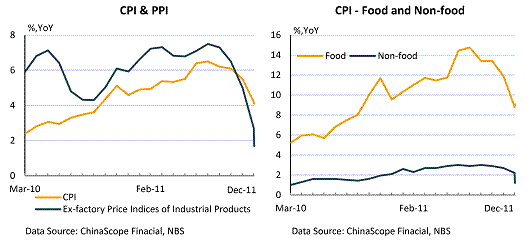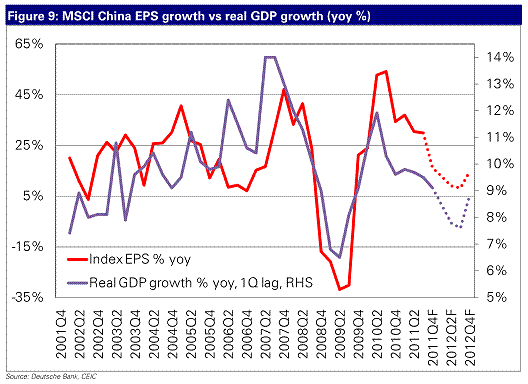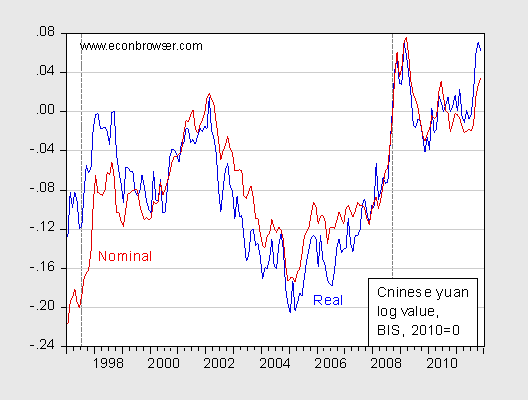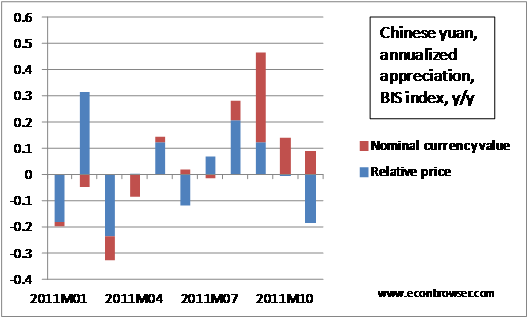Chinese inflation is decelerating [0]. This suggests that whatever further real CNY appreciation occurs is likely arise from nominal appreciation, over the near term.
The news, not completely unexpected, is that inflation is falling rapidly.

Figure 1: CPI, PPI, and CPI food and nonfood y/y inflation. Source: Daily Dim Sum, China Scope Financial (January 12, 2012).
This can be taken two ways: first, the economy is cooling rapidly; second, the fiscal and monetary authorities have more scope for stimulative action should growth further slow.

Figure 9 from Jun Ma, Hui Miao, “China: Themes and
Strategy for 2012 — From slowdown to recovery,” Deutsche Bank, January 4, 2012.
What are the implications for the Chinese currency’s real value? Despite the shrinkage in the Chinese trade balance, continued global rebalancing requires continuous CNY appreciation. (According to Chinese statistics, the 2011 trade surplus of USD155 billion was 14.5% smaller than the 2010 balance).
The Chinese indices are available only up to November; the BIS real index is almost back to the crisis peak, when the CNY followed the USD in its rise.

Figure 2: Log real trade weighted CNY (blue), nominal CNY (red). Upward denotes appreciation. Dashed line at East Asian crisis (1997M07), and Lehman (2008M09). Source: BIS, Dec. 15, 2011.
What is interesting is how much the nominal and real have diverged at the end of 2010 (as pointed out in this post), and over most of 2011. Using the definition of the real value of the exchange rate (logs):
r ≡ e + pRoW – pCh
Where r is the log real value of the Chinese yuan, e is the value of the Chinese yuan in units of foreign currency per Chinese yuan, and pCh is the log Chinese CPI. (This definition implies an increase is an appreciation.) Then:
Δ r ≡ Δ e + Δ pRoW – Δ pCh
Using this decomposition, one can identify how much of the real appreciation is due to nominal exchange rate changes and how much to price changes.

Figure 3: Components of Real Chinese Trade Weighted Yuan Appreciation, calculated as log differences, annualized. Source: Source: BIS, Dec. 15, 2011, and author’s calculations.
At the end of last year, and in the third quarter of this year, relative inflation added a substantial boost toward CNY appreciation. With decelerating Chinese inflation, continued appreciation will depend on nominal appreciation. Unfortunately, most forecasters are guessing that Chinese policy authorities will allow only very slow nominal appreciation against the USD (2.7% mean) [1]. (Of course, the effective value of the CNY will depend on the path of the USD, which is likely in my view to be upward in 2012.)
Also, in my view, the deterioration in global output prospects should add extra inducement to Chinese policymakers to rebalance their economy toward domestic sources of aggregate demand. But I think the actual outcome will depend at least as much as on political economy factors as broad macroeconomic interests.
Thanks Professor Chinn. I am wondering if the Chinese CPI numbers are that reliable, see e.g. http://www.reuters.com/article/2011/02/16/us-china-economy-inflation-idUSTRE71F27K20110216. Are there some ways to check for their realism, for instance estimating a Phillips curve for China?
http://www.kitco.com/scripts/hist_charts/yearly_graphs.plx
This is econometrics at its worst. If you want to understand why China’s inflation is declining all you have to do is look at a graph of the dollar price of gold. The RMB is essentially tied to the $. When the $ is stable the RMB is stable. Calculations of the nominal and real exchange value of a currency is essentially a guess. We can see the exchange value and the change in exchange value but that is always real, because that is what traders will trade for. Any manipulation of numbers is just economic sudoku, but that’s okay, sudoku is fun sometimes, and getting paid a huge salary to do sudoku is even better.
Minh Trinh: I have no additional information on the accuracy of the Chinese CPI, but I agree we should be wary. I’m sure that at the various investment bank research departments try to assess the series by relating to subindices and alternative deflators.
Ricardo: I had hoped we had expunged references to Sudoku from your comments, but I see that hope has been dashed. Oh, well.
Just to be clear, the post was “econometrics-free”; hence, I feel you must have a mis-apprehension of what is — and is not — econometrics.
Menzie,
What do you have against sudoku? I thought you liked it.
Ricardo: I have nothing against it, having never tried it. I object to the relentless use of the metaphor over and over and over again, so much so I feel like I am listening to a broken record. Variety is the spice of life… in writing as well.
Nice post.
Thanks for a helpful post.
The ‘rebalancing’ you often reference sounds so benign. But it is the stuff of Chinese recession, the more painful & extended because the govt there will do all they can to thwart market forces & honest prices. Even worse than we do here.